| Article ID | Journal | Published Year | Pages | File Type |
|---|---|---|---|---|
| 9416585 | Brain Research | 2005 | 9 Pages |
Abstract
The activation of transient receptor potential vanilloid receptor 1 (TRPV1) by capsaicin in rat brain stimulates gastric acid secretion via tachykinin NK2 receptors and the vagus cholinergic nerve, but the involvement of other receptor systems has not been elucidated. We investigated the role of the glutamate and γ-amino-butyric acid (GABA) receptor systems on the capsaicin response. Gastric acid secretion stimulated by the injection of capsaicin (30 nmol) into the lateral cerebroventricle (i.c.v.) was inhibited by 6-cyano-7-nitroquinoxaline-2,3-dione (CNQX, an antagonist of non-N-methyl-d-aspartate (non-NMDA) receptors, 10.9 nmol, i.c.v.) and bicuculline (a GABAA receptor antagonist, 222 μg kgâ1 10 minâ1, i.v. infusion). Secretion stimulated by the injection of capsaicin (50 nmol) into the fourth cerebroventricle was inhibited by CNQX and bicuculline. I.c.v. injection of anandamide (an endogenous ligand of TRPV1 and cannabinoid receptors, 30 and 100 nmol) stimulated gastric acid secretion, and the response was inhibited by an antagonist of TRPV1 and in the capsaicin-treated rats, but not by an antagonist of cannabinoid receptors. In conclusion, the TRPV1 system, which is activated by capsaicin and anandamide, is preferentially coupled with non-NMDA and GABAA receptor systems in the brain and stimulates gastric acid secretion in rats.
Keywords
Related Topics
Life Sciences
Neuroscience
Neuroscience (General)
Authors
Sachie Minowa, Satomi Ishihara, Shizuko Tsuchiya, Syunji Horie, Toshihiko Murayama,
